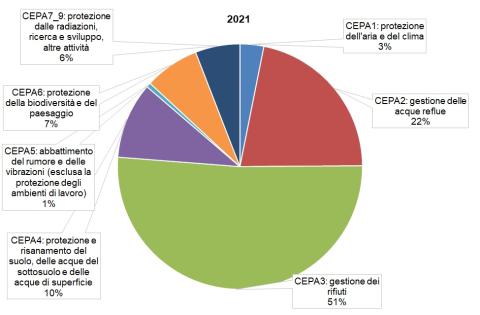Panel 1
Renato Marra Campanale
In 2021, the level of expenditure in the Italian economy for environmental protection amounted to 46.6 billion euros, equivalent to 2.6% of Gross Domestic Product (GDP). This ratio is the highest recorded since 2016, although it remained substantially stable between 2016 and 2021. Expenditure on environmental protection mainly concerns waste management and wastewater management. Other environmental protection purposes include, in order of importance, soil protection and remediation, groundwater and surface water protection; biodiversity and landscape protection; protection from radiation, research and development, other activities; air and climate protection; noise and vibration reduction (excluding workplace environmental protection).
The indicator quantifies, for an economy as a whole and/or for the various operators within it, the amount of national resources (net of funding received from the rest of the world) spent on environmental protection by resident operators, regardless of the origin of these resources; each resident operator can spend drawing from their own resources and/or from resources received from other resident operators (resources, for example, through transfers). National expenditure on environmental protection is determined before depreciation. National expenditure on environmental protection is the main indicator derived from the environmental protection expenditure account. It is defined as the sum of: final consumption of environmental protection services by resident units; intermediate consumption of environmental protection services by resident units excluding specialized producers; gross fixed investments and acquisitions minus disposals of non-produced non-financial assets for the implementation of environmental protection activities; environmental protection transfers that are not the counterpart of the previous aggregates, minus funding from the rest of the world.
The purpose is to identify and measure the responses of the economy to environmental problems through the supply and demand for environmental protection services. Indicators of the environmental protection expenditure account, eco-industries, and environmental tax revenue make explicit the environmentally relevant economic transactions not highlighted in the core national accounts.
Commission Delegated Regulation (EU) No. 125/2022, which amended the previous Regulation EU 691/2011 on environmental-economic accounts.
Panel 2
Environmental protection expenditure accounts Handbook — 2017 edition. Eurostat, Luxembourg (https://ec.europa.eu/eurostat/web/products-manuals-and-guidelines/-/KS-GQ-17-004) - System of Environmental-Economic Accounting 2012 - Central Framework. United Nations, New York, 2014 (https://seea.un.org/content/seea-central-framework)
Data quality assessment
Istat database - http://dati.istat.it/# --> Conti nazionali --> Conti ambientali --> Spese per la protezione dell'ambiente
National
2016-2021
Indicator assessment
The methodology for processing the indicator can be found in the document Environmental protection expenditure accounts Handbook — 2017 edition. Eurostat, Luxembourg (https://ec.europa.eu/eurostat/web/products-manuals-and-guidelines/-/KS-GQ-17-004). The environmental protection expenditure account, in line with national economic accounting, presents data on the economic resources allocated to environmental protection by resident units. The following variables are considered: -Production of environmental protection services (distinguished between market production, non-market production, and auxiliary activities); - Intermediate consumption of environmental protection services; -Intermediate consumption of environmental protection services for the production of environmental protection services; -Imports and exports of environmental protection services; -Value-added tax (VAT) and other taxes, net of subsidies, on environmental protection services; -Gross fixed capital formation and acquisitions minus disposals of non-financial non-produced assets for the production of environmental protection services; -Final consumption of environmental protection services; -Transfers destined for environmental protection (received/paid), disaggregated by type of producer/consumer of environmental protection services: Public administrations (including non-profit institutions serving households) and businesses as institutional sectors producing environmental protection services; -Households, public administrations, and businesses as consumers of environmental protection services; -The rest of the world as a beneficiary or source of environmental protection transfers; and by classes or groupings of classes of environmental protection activities (CEPA).
The CEPA classification includes: 1. Air and climate protection; 2. Wastewater management; 3. Waste management; 4. Soil and groundwater protection; 5. Noise and vibration reduction; 6. Biodiversity and landscape protection; 7. Protection from radiation; 8. Research and development for environmental protection; 9. Other environmental protection activities.
In 2021, the level of expenditure in the Italian economy for environmental protection amounted to 46.6 billion euros, equivalent to 2.6% of GDP (Table 1), which is broadly in line with the European average (2.2%).
Between 2016 and 2021, expenditure on environmental protection in the Italian economy increased by only 0.3 percentage points in relation to GDP, showing an almost stable trend over the period (Table 1).
Data
Table 1: National expenditure for environmental protection by institutional sector and CEPA, and ratio to GDP.
Istat


In 2021, expenditure on environmental protection mainly concerned waste management and wastewater management, which represented 51% and 22% of total environmental protection expenditure, respectively (Figure 1 and Table 1). Other environmental protection purposes include, in order of importance, soil protection and remediation, groundwater and surface water protection; biodiversity and landscape protection; protection from radiation, research and development, other activities; air and climate protection; noise and vibration reduction, excluding workplace environmental protection (Table 1 and Figure 1).
"Companies" accounted for over half (52%) of total expenditure in 2021, while "Public administrations and private social institutions serving households" and "Households" covered 27% and 21%, respectively. These shares have remained quite stable from 2016 to 2021 (Table 1).